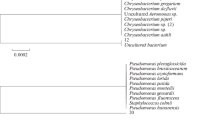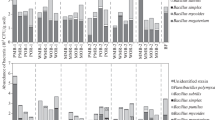Abstract
Direct and inoculation methods indicated high concentrations of bacteria on the following plants: Carex nigra, Eriophorum vaginatum, Drosera rotundifolia, and Ledum palustre. The correlation between bacterial abundance, species, and organs of the studied plants was revealed. Proteobacteria were shown to predominate in the phyllosphere, while bacilli and actinomycetes prevailed in rhizoplane and rhizosphere. Members of the genera Pseudomonas and Erwinia predominated in the phyllosphere. High values of the nitrogen-fixing activity of bacterial populations in the rhizosphere were revealed, which reached a maximum in the rhizosphere under sundew.
Similar content being viewed by others
References
Golovchenko, A.V., Pankratov, T.A., Dobrovol’skaya, T.G., and Kukharenko, O.S., Bog soils as a bank of bacterial variety, in Rol’ pochv v biosfere (Role of Soils in Biosphere), Tr. Inst. Ekol. Pochvoved., Mosk. Gos. Univ., Moscow, 2010, no. 10.
Dobrovol’skaya, T.G., Struktura bakterial’nykh soobshchestv pochv (Structure of Soil Bacterial Communities), Moscow, 2002.
Dobrovol’skaya, T.G., Golovchenko, A.V., and Zvyagintsev, D.G., Analysis of ecological factors limiting the destruction of high-moor peat, Eurasian Soil Sci., 2014, vol. 47, no. 3, pp. 182–194.
Dobrovol’skaya, T.G., Khusnetdinova, K.A., Manucharova, N.A., and Golovchenko, A.V., Structure of epiphytic bacterial communities of weeds, Microbiology (Moscow), 2017, vol. 86, no. 2, pp. 257–264.
Zvyagintsev, D.G., Dobrovol’skaya, T.G., and Lysak, L.V., Plants as the centers for forming bacterial communities, Zh. Obshch. Biol., 1993, vol. 54, no. 2.
Kononkov, F.P. and Umarov, M.M., Nitrogen fixation in southern taiga forests, Lesovedenie, 1982, no. 6.
Lysak, L.V., Dobrovol’skaya, T.G., and Skvortsova, I.N., Metody otsenki bakterial’nogo raznoobraziya pochv i identifikatsii pochvennykh bakterii (The Ways to Estimate Soil Bacterial Variety and to Identify Soil Bacteria), Moscow, 2003.
Metody pochvennoi mikrobiologii i biokhimii (Methods of Soil Microbiology and Biochemistry), Moscow, 1991.
Miglovets, M.N., Methane emission in floral communities of middle taiga mesooligotrophic swamp, Teor. Prikl. Ekol., 2014, no. 1.
Bergey’s Manual of Systematic Bacteriology, New York: Springer-Verlag, 2012, vols. 1–2.
Pankratov, T.A., Belova, S.E., and Dedysh, S.N., Evaluation of the phylogenetic diversity of prokaryotic microorganisms in Sphagnum peat bogs by means of fluorescence in situ hybridization (FISH), Microbiology (Moscow), 2005, vol. 74, no. 6, pp. 722–729.
Razgulin, S.M., Atmosphere nitrogen fixation in different types of forests at southern taiga, Lesovedenie, 1995, no. 4.
Umarov, M.M., Kurakov, A.V., and Stepanov, A.L., Mikrobiologicheskaya transformatsiya azota v pochve (Nitrogen Microbiological Transformation in Soil), Moscow, 2007.
Albino, U., Saridakis, D.P., Ferreira, M.C., et al., High diversity of diazotrophic bacteria associated with the carnivorous plant Drosera villosa var. villosa growing in oligotrophic habitats in Brazil, Plant Soil, 2006, vol. 287, no. 1–2, pp. 199–207.
Jacques, M.A. and Morris, C.E., A review of issues related to the quantification of bacteria from the phyllospere, FEMS Microbiol. Ecol., 1995, vol. 18, no. 1, pp. 1–14.
Manucharova N.A., Vlasenko A.N., Tourova T.P., et al., Thermophilic chitinolytic microorganisms of brown semidesert soil, Microbiology (Moscow), 2008, vol. 77, no. 5.
Opelt, K. and Berg, G., Diversity and antagonistic potential of bacteria associated with bryophytes from nutrient-poor habitats of the Baltic sea coast, Appl. Environ. Microbiol., 2004, vol. 70, no. 11.
Pouliot, R., Rochefort, L., Karofeld, E., and Mercier, C., Initiation of sphagnum moss hummocks in bogs and the presence of vascular plants: is there a link?, Acta Oecol., 2011, vol. 37, no. 4, pp. 346–354.
Redford, A.J. and Fierer, N., Bacterial succession on the leaf surface: a novel system for studying successional dynamics, Microb. Ecol., 2009, vol. 58, no. 1.
Tsitko, I., Lusa, M., Lehto, J., et al., The variation of microbial communities in a depth profile of an acidic, nutrient-poor boreal bog in southwestern Finland, Open J. Ecol., 2014, no. 4.
Author information
Authors and Affiliations
Corresponding authors
Additional information
Russian Text © T.G. Dobrovol’skaya, A.V. Golovchenko, E.N. Yurchenko, N.V. Kostina, 2019, published in Vestnik Moskovskogo Universiteta, Seriya 17: Pochvovedenie, 2019, No. 1, pp. 42–46.
About this article
Cite this article
Dobrovol’skaya, T.G., Golovchenko, A.V., Yurchenko, E.N. et al. Composition of Bacterial Communities of the Main Types of Bog Plants. Moscow Univ. Soil Sci. Bull. 74, 40–43 (2019). https://doi.org/10.3103/S0147687419010046
Received:
Published:
Issue Date:
DOI: https://doi.org/10.3103/S0147687419010046




